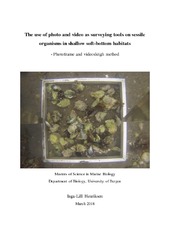| dc.contributor.author | Henriksen, Inga-Lill | |
| dc.date.accessioned | 2018-04-23T14:19:17Z | |
| dc.date.available | 2018-04-23T14:19:17Z | |
| dc.date.issued | 2018-04-18 | |
| dc.date.submitted | 2018-04-17T22:00:05Z | |
| dc.identifier.uri | https://hdl.handle.net/1956/17633 | |
| dc.description.abstract | The Institute of Marine Research (IMR) wants to start a systematic survey of shallow, soft-bottom habitats. The IMR wants to implement two new methods using photo and video, the photoframe and the videosleigh method. Where analyzing of an investigation area is done by photo or video instead of in situ. The target groups were Pacific oyster, European flat oyster, Blue mussel and macroalgae. Both methods were tested to see if number of individual Pacific oyster, European flat oyster and Blue mussel could be estimated by use of photo and video. It was also seen if these species could be categorized based on vital status, and if percentage of macroalgae could be estimated. The photoframe method were also tested for measuring of size, both length and width, of Pacific oyster, European flat oyster and Blue mussel. This was tested by comparing data registered by photo or video against in situ registrations done by skin-divers in the field. The biology of the bivalve species affected the results. This was apparent through underestimation caused by individuals growing onto each other and misclassification of species, especially for Pacific oyster and European flat oyster. Orientation of Blue mussel affected the precision and accuracy of measuring, and in some cases made measuring not possible. Estimating number of individuals was possible when using both methods. Only videosleigh method seemed suitable for categorization of bivalve species based on vital status and estimating percentage coverage of macroalgae. Estimation of size by photo was possible for Pacific oyster and European flat oyster. Determining cohorts by analysis of photo was not possible for either species. Both methods were time-effective regarding analyzing, the analyzation place was moved and both methods were therefore cost-effective. Both methods may be used as a surveying tool in the future, where each method has its strengths and weaknesses. For a systematic survey on soft-bottom habitats, a combination of the methods as they are now may be advantageous. | en_US |
| dc.language.iso | eng | eng |
| dc.publisher | The University of Bergen | en_US |
| dc.subject | Foto | eng |
| dc.subject | Macroalgae | eng |
| dc.subject | dekningsgrad | eng |
| dc.subject | Pacific oyster (Crassostrea gigas/Magallana gigas) | eng |
| dc.subject | Photo | eng |
| dc.subject | video | eng |
| dc.subject | Blåskjell (Mytilus edulis) | eng |
| dc.subject | Flatøsters (Ostrea edulis) | eng |
| dc.subject | Number | eng |
| dc.subject | Antall | eng |
| dc.subject | alien species | eng |
| dc.subject | videosleigh | eng |
| dc.subject | European flat oyster (Ostrea edulis) | eng |
| dc.subject | photoframe | eng |
| dc.subject | Makroalgaer | eng |
| dc.subject | coverage | eng |
| dc.subject | grunne bløtbunnshabitater | eng |
| dc.subject | Blue mussel (Mytilus edulis) | eng |
| dc.subject | fotoramme | eng |
| dc.subject | Beskyttede | eng |
| dc.subject | size | eng |
| dc.subject | videoslede | eng |
| dc.subject | Sheltered | eng |
| dc.subject | fremmed art | eng |
| dc.subject | størrelse | eng |
| dc.subject | soft-bottom habitat | eng |
| dc.subject | Stillehavsøsters (Crassostrea gigas/Magallana gigas) | eng |
| dc.title | The use of photo and video as surveying tools on sessile organisms in shallow soft-bottom habitats - Photoframe and videosleigh method | en_US |
| dc.type | Master thesis | |
| dc.date.updated | 2018-04-17T22:00:05Z | |
| dc.rights.holder | Copyright the Author. All rights reserved | en_US |
| dc.description.degree | Masteroppgave i biologi | en_US |
| dc.description.localcode | BIO399 | |
| dc.subject.nus | 751999 | eng |
| fs.subjectcode | BIO399 | |
| fs.unitcode | 12-60-00 | |
